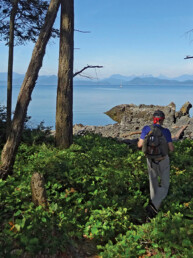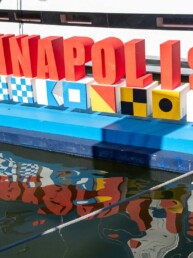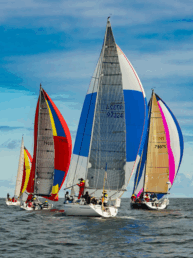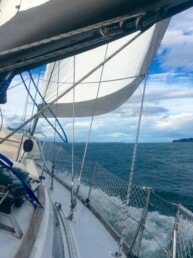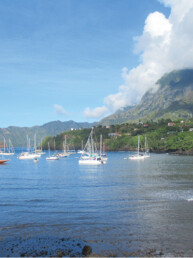This article originally appeared in the June 2021 issue of 48° North.
Night had begun to return since leaving the last settlement of Cambridge Bay. Headed west, the wind on our nose, Breskell pounded into the teeth of the Dolphin and Union Strait. At times, she launched off one wave and slammed into the next, shuddering for several seconds on impact. As we ducked behind Read Island to anchor out the storm, we bumped over something unmarked, a constant danger in the poorly charted Arctic. The virtues of Breskell’s swing keel were clear when it avoided damage, pivoting up and over the obstacle. Carrying on after the blow in the Amundsen Gulf, we struck a growler, an iceberg too small to show up on the radar but big enough to smash a hole in Breskell’s upper topside. We made an on-the-water repair which worked until, headed into the teeth of the Beaufort Sea, it didn’t. The bailing commenced, and we headed to Tuk.
After a rough leg, a weary crew of four tied up to the earthen and timber public dock in Tuktoyaktuk to re-provision, repair, and recoup. It was August 27, 2019, and Breskell, a 50-foot, yellow, wooden, cold-molded, sloop-rigged sailboat, built and captained by Olivier Huin, was only halfway through her voyage. We had left St. John’s, Newfoundland, in mid-July, bound for Port Townsend, Washington, via the fabled Northwest Passage.
The Northwest Passage, a sea route through the Arctic Ocean, was elusive to 19th-century explorers, sometimes ending in tragedy, as was the case for the infamous Sir John Franklin expedition in the late 1840s. They braved the unknown and unpredictable cold and ice of the Canadian Arctic Archipelago in search of a shorter shipping route between the Atlantic and the Pacific Oceans. The icy conditions of the time clogged the waterways, and their slow wooden ships were unable to transit in one season. If frozen in, their hulls risked being crushed by the pressure of the shifting ice. Crews faced a long, dark, cold, and hungry winter (or winters) of survival conditions, with only a remote chance of rescue in the short summer seasons.
Now, some two hundred years later, and especially since 2000, things are different. The arctic climate has warmed enough to adequately melt the ice in July and August for modern boats to pass, with several transits per year by government, commercial, and recreational vessels. After the season of 2019, an unofficial list placed Breskell among the latest of only 313 transits of the Northwest Passage in recorded history. Of those, over 240 of them have been in the 21st century alone.1
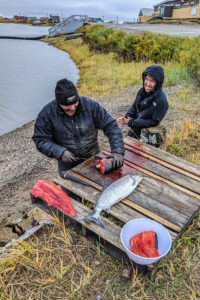 Tuktoyaktuk, or Tuk for short, is a settlement in the Northwest Territory of mainland Canada, on the edge of the Arctic Ocean, about 175 NM east of the Alaskan border. Starting as a place to hunt caribou and whales, it then became an English trading post.2 In the 1950s, it became a Distant Early Warning Line station and a DEW Line resupply hub. More recently, Tuk has been a base for oil and gas exploration. Well above the Arctic Circle, the community of less than a thousand is nestled among the pingos (ice-hills only found in permafrost regions) at the end of a new and long road from the south. The significance of this is that Tuk can be supplied by sea, by air, AND by land. This makes it a strategic re-provisioning stop for boats transiting the Northwest Passage. Breskell, traveling from east to west, had been island hopping from the get-go, and Tuk was the first stop of the voyage on the North American mainland. The public dock allowed for convenient — relatively speaking — access to groceries, diesel, oil, and water.
Tuktoyaktuk, or Tuk for short, is a settlement in the Northwest Territory of mainland Canada, on the edge of the Arctic Ocean, about 175 NM east of the Alaskan border. Starting as a place to hunt caribou and whales, it then became an English trading post.2 In the 1950s, it became a Distant Early Warning Line station and a DEW Line resupply hub. More recently, Tuk has been a base for oil and gas exploration. Well above the Arctic Circle, the community of less than a thousand is nestled among the pingos (ice-hills only found in permafrost regions) at the end of a new and long road from the south. The significance of this is that Tuk can be supplied by sea, by air, AND by land. This makes it a strategic re-provisioning stop for boats transiting the Northwest Passage. Breskell, traveling from east to west, had been island hopping from the get-go, and Tuk was the first stop of the voyage on the North American mainland. The public dock allowed for convenient — relatively speaking — access to groceries, diesel, oil, and water.
I recalled a previous stop at Baffin Island’s Pond Inlet on the east side of the Passage and the unenviable task of ferrying 800 liters of diesel in bladders from the beach in the dinghy. Breskell was pitching in the sloppy anchorage, and the surf was topping my boots. The ailing outboard engine was behaving in fits and starts, and while I had oars, I discovered the oarlocks to be absent. So, yes, I considered Tuk to be high style indeed. But while provisioning and repairs were the heart of our stop and the lifeblood of our expedition, they were not the soul. I reserve those honors for a local named Bruce, and a vagrant fish. This story is really about them.
I met Bruce by chance upon returning to the dock after surveying Tuk’s provisioning establishments. Captain Huin had tasked me with tracking down some oil for Breskell’s Perkins diesel, as well as a contact for fuel delivery and some sealant for the topside repair. Bruce, his dark face and eyes outlined by dark-but-silvering facial hair, wore a black Tuktoyaktuk beanie with a white beluga whale embroidered on it. There was a skiff on the beach adjacent to the public dock, and he was loading it up with gear from his late-model pickup truck. We made eye contact, so I said hello and asked him how he was. His response was friendly, so I continued to engage.
“I was wondering about that skiff,” I said. Bruce explained he used it to check his fishing nets. The catch would feed his dogs, which he kept on an island about 200 meters off the dock. “Oh, I was wondering about them too.” When Breskell approached the public dock on arrival, we passed a low-lying island about the size of a football field. It was barren except for a pack of dogs, a few doghouses, and well-trodden tundra.
Dogs are plentiful across the Arctic communities. Cautious not to impose outsider cultural values, my observation was they were considered more as wintertime tools for pulling sleds and less as pets. These were not house dogs. In Sisimiut, Greenland, there were acres of dogs in what I dubbed Hound Town, just outside the city. While the young pups had free reign, each adult was chained or penned, their masters visiting daily to feed them. They had humbly built doghouses with an interior baffle to provide extra shelter from the frigid Arctic wind. This scene would repeat itself in various forms across the Arctic settlements. In Tuk, Bruce’s solution was to isolate the dogs on this island.
“What kind of fish will you catch?” I queried. He would likely be catching salmon, to which I naively expressed joy. He agreed it was delicious but explained that for Tuk, salmon was a disrupting fish. Traditionally, he would be catching whitefish. But as another apparent sign of a changing climate and water temperatures, Pacific Salmon have been extending their range farther north.3 For better or worse, the introduction of an outside species will affect the ecosystem. As a Puget Sound resident where the salmon is highly regarded, protected, and presently in short supply, I found it fascinating that Tuk residents considered it a vagrant species.
We parted ways, each of us getting on with our missions. I reported my recon to Captain Huin, then set out for the final purchases. As I returned to the dock, so had Bruce. He had checked the nets, fed the dogs, and was at the beach dressing out a few salmon. Joined by Eric, Breskell‘s mate, we talked about living in the area year-round and how he was a subsistence hunter and fisherman. The cost of imported food was high. Fishing and hunting, as his ancestors had been doing for generations, were still viable. And sometimes it meant food to go around. To illustrate his point, Bruce handed Eric and me a large dressed out salmon.
Breskell had a large variety of foodstuffs on board, but fresh meat was not one of them. Lumpy sea conditions and the cycles of watch standing can often inhibit sophisticated cooking while underway. Rice, noodles, bacon, and canned fare were regulars, with long-lasting cabbage as a staple too. Freshly caught salmon was going to be an extra special treat and good for morale. It was exciting. Breskell had our own fishing pole we hung off the stern, but our typical speed of 7 knots appeared to be too fast for results. We did have seagulls trying to snatch our hydroplaning lures, luckily without success. Eric and I passed the salmon on to Leila, Breskell‘s head chef, for preparation. That evening we invited Amanda and Robin from Morgane, another transiting sailboat, over for dinner. Both the fish and the company made for a beautiful and memorable experience.
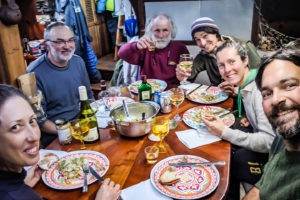 Twenty-nineteen saw 24 boats transiting the Northwest Passage; two in 2018, an icy year; 32 in 2017; and 18 in 2016.4 For a settlement such as Tuk, the arrival of boats transiting the Northwest Passage is a budding tourism industry. When locals hear about visitors, they go to the docks offering crafts such as carved stone for sale. For Breskell‘s part, we purchased motor oil, groceries, and hundreds of liters of delivered diesel fuel, spending $1,000 CAD in Tuk alone. Likewise, in Cambridge Bay before that, adding water to the tally. Cruise ships are among those numbers too. In Pond Inlet, one arrived in the anchorage just after Breskell and commenced to shuttle passengers to and from the shore for the next few hours. Coincidentally, their wakes contributed to the sloppy anchorage of my diesel-ferrying ordeal.
Twenty-nineteen saw 24 boats transiting the Northwest Passage; two in 2018, an icy year; 32 in 2017; and 18 in 2016.4 For a settlement such as Tuk, the arrival of boats transiting the Northwest Passage is a budding tourism industry. When locals hear about visitors, they go to the docks offering crafts such as carved stone for sale. For Breskell‘s part, we purchased motor oil, groceries, and hundreds of liters of delivered diesel fuel, spending $1,000 CAD in Tuk alone. Likewise, in Cambridge Bay before that, adding water to the tally. Cruise ships are among those numbers too. In Pond Inlet, one arrived in the anchorage just after Breskell and commenced to shuttle passengers to and from the shore for the next few hours. Coincidentally, their wakes contributed to the sloppy anchorage of my diesel-ferrying ordeal.
The Canadian government has a territorial, political, and economic interest in the Canadian Arctic Archipelago and its surrounding waters, including the Northwest Passage. With more favorable conditions and reliable transiting, the significance of development and control is increasing. In 2020, Transport Canada closed the Passage to most pleasure craft due to COVID-19, and cruise ships were not operating. Local and essential traffic were exempted, along with those “exercising the Right of Innocent Passage,” which means no stopping.5 2021 is still a question mark. As the Arctic continues to warm and travel resumes, it seems likely the numbers of boats, passengers, and services will increase too.
But in 2019, Bruce’s act of kindness transcended pure commerce. The chance of the encounter and the spirit of the action combined for an exceptional moment. I’ve had similar interactions with people on expeditions before. The adventure captured their imagination. Offering unsolicited aid allowed them to live it vicariously. With Bruce, interactions were brief, and I’ll not purport to know his motivations. Maybe he was teaching us about local life, tradition, generosity, and subsistence? With dogs to feed, he would be checking his nets every day. Maybe he had more fish than he knew what to do with? Or he simply wanted to be kind to strangers. Whatever the reasons, his acts of friendliness and inclusion were welcomed and contagious, and I am glad I took the chance to say hello.
The rhythm of living and voyaging on a small boat, the constant closeness of the crew, coupled with isolation from the rest of society, makes this encounter memorable. Bruce’s friendship and conversation, especially after a particularly challenging leg of Breskell‘s journey, was a positive and refreshing reminder of the outside world and a morale boost. Human connection and kindness are what often make a lasting impression wherever we may travel.
Foot Notes:
1 www.spri.cam.ac.uk/resources/infosheets/northwestpassage.pdf
2 www.tuktoyaktuk.ca/
3 www.dfo-mpo.gc.ca/oceans/soto-rceo/arctic-arctique/publications/public-report/index-eng.html
4 www.spri.cam.ac.uk/resources/infosheets/northwestpassage.pdf 2
5 www.2.tc.gc.ca/eng/mediaroom/interim-order-restricting-pleasure-craft-navigation-covid19.html
Josh Wheeler
Josh Wheeler is an avid writer and sailor who lives aboard on his 20-foot Flicka sailboat. Follow his adventures at sailingwithjosh.com

